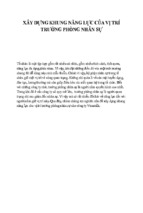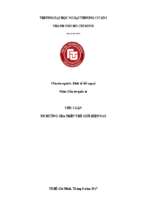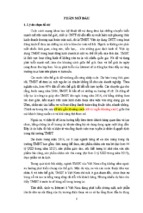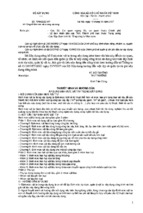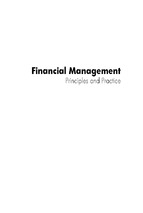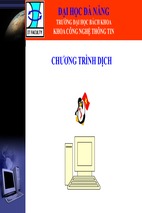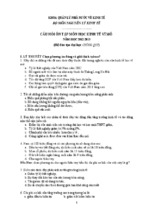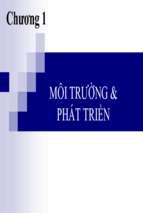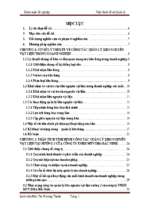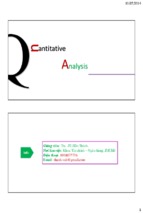THE WORLD’S MATTEL
Contents
A.
Company Background ............................................................................................. 1
B.
Analyse Credit Standard of Mattel: .........................................................................3
I. Financial Analysis .................................................................................................3
1.
Market value of company ...............................................................................5
2.
Liquidity .........................................................................................................6
3.
Debt management & Coverage ......................................................................8
4.
Performance ....................................................................................................9
Five Cs ‘ model Analyse: .................................................................................10
II.
C.
1.
Character : .....................................................................................................10
2.
Capital :.........................................................................................................11
3.
Capacity ........................................................................................................12
4.
Condition: .....................................................................................................13
5.
Collateral: .....................................................................................................15
Conclusion: ............................................................................................................15
A. Company Background
In 1945, Harold "Matt" Matson and Elliot Handler founded Mattel Creations in El
Segundo, California, although Matson sold his stake to Handler soon after founding. The
company started out making picture frames, with a side business in making dollhouse
furniture from the scraps. Eventually Mattel turned its wood working equipment to making a
child-sized ukulele, and the company had its first hit product. Mattel began manufacturing
other kinds of toys, and by 1955 it was worth a half million dollars and had attracted the
attention of the Walt Disney Company. Disney offered Mattel a gamble: they could sponsor a
segment of the newly developed Mickey Mouse Club for a year, but it would cost nearly the
entire net worth of the company. The Handlers took the bet, revolutionizing advertising in the
toy industry and nearly tripling Mattel's sales in just three years. The Handlers compounded
their success by introducing the Barbie doll, named after their daughter Barbara, in 1959.
In 1977, Mattel entered the electronics game industry as part of its diversification strategy,
introducing the Intellivision, a direct competitor to the Atari 2600. Unfortunately, for Mattel,
the American video games industry collapsed a few years later, and many of their non-toy
ventures were taking substantial losses. By 1984, Mattel had either sold off or closed all nontoy-related subsidiaries to refocus on their core business.
After their disastrous diversification attempts, Mattel launched an internal campaign to
maximize their core brands while also looking for new brands with core potential. A major
part of this campaign was to renew the company's association with Disney, forming an
alliance that gave Mattel the licenses for not only Disney's classic characters, but their
contemporary hits as well. Another major component of the campaign was another round of
acquisitions, this time focusing on other toy companies with solid core products. Mattel
1
THE WORLD’S MATTEL
acquired Fisher-Price, Power Wheels, Cabbage Patch Kids and others, and they merged with
Tyco Toys. The 1990s were a period of rapid growth for the company.
While Mattel continued to amass companies and product licenses, including the lucrative
Harry Potter license agreement and a multi-year licensing deal with children's programming
network Nickelodeon, the 2000s also brought serious challenges for Mattel. In 2000, the
company sold off The Learning Corporation, a software company Mattel had bought for $3.5
billion in stock in 1999, in a zero•cash•upfront deal with an investment firm in order to get the
failing software division off its books. The Learning Company, which had been rebranded as
Mattel Interactive, was losing an estimated $1 million per day, and its acquisition by Mattel
has been regarded as one of the worst purchases in American corporate history. Mattel took a
$430 million after-tax loss on The Learning Company, and they saw an estimated $7 billion
drop in market valuation attributable to the failed software division. The next year Mattel
entered into licensing agreements with game publishers Vivendi Universal and the nowdefunct THQ to develop interactive properties based on Mattel's products, rather than making
another attempt to acquire a software division.
Mattel faced another formidable challenge from rival MGA Entertainment, which
launched the Bratz line of dolls in 2001. By 2005, Bratz had nearly overtaken Barbie in sales,
leading to a 30% decline in sales of Mattel's flagship doll worldwide, as Bratz climbed to a
40% market share. Mattel filed a lawsuit against MGA in 2004, alleging that a Mattel
employee had come up with the concept of the Bratz doll before being hired away by MGA.
Although the courts eventually ruled in favor of MGA after nearly a decade of litigation, the
court costs weakened MGA's ability to continue the meteoric growth of the Bratz line, and
today the doll line is a shadow of itself. MGA counter-filed against Mattel alleging corporate
espionage, and, although the suit was denied by the US Court of Appeals, MGA has recently
re-filed the suit, claiming the initial suit only lost on a technicality. While MGA seeks a
billion dollars in damages from Mattel, it is unlikely the suit will succeed on its second try.
The ongoing battle between the two companies is notable as one of the most heavily contested
trade secret cases in American legal history.
In 2007, Mattel faced a serious crisis regarding its manufacturing processes. The small
magnets in many of Mattel's toys were found to cause potentially fatal internal injuries if
accidentally swallowed, as they could clamp intestines together. Shortly afterwards, a separate
report found that Mattel's Chinese manufacturing plants were using paint with high lead
concentrations. Mattel's response to the crisis, including multiple recalls totaling over 18
million products, a website coordinating product safety information, and public apologies by
then CEO Rob Eckert both on television and the corporate website2 were lauded as the new
industry standard. Mattel received positive coverage for its handling of the crisis, and, in
2007, were still named as one of Top 100 Best Corporate Citizens. As of 2014, they are still
ranked as one of the most ethical companies in the US3.
Despite challenges and setbacks, Mattel continued to be a powerhouse toy manufacturer into
the 2010s. Mattel had already enjoyed moderate success from their direct•to•DVD Barbie
movies, which had earned more than $100 million since 2001. That number pales in
comparison to the $470 million in box-office sales from The Lego Movie in 2014, or the $3.7
billion generated by Hasbro's Transformers movies.
After consolidating the HiT acquisition, Mattel next bought MEGA Brands Inc. for $460
million in 2014 in an attempt to break into the lucrative construction toy market, where Lego
reigns with a 90% market share.
2
THE WORLD’S MATTEL
Since 2013, though, Mattel has experienced a reversal of fortune. A disappointing 4th quarter,
the most important quarter for Mattel's highly seasonal sales, caused the company to miss
earnings targets in 2013 and began a slump that would eventually see the firing of CEO Bryan
Stockton on January 26, 2015, after five straight quarters of declining sales. The company
also slipped from the largest toy maker in the world to the second largest, losing its crown to
Lego. Now Mattel is struggling to rejuvenate its core brands and rebuild its market share in a
fiercely competitive market.
B. Analyse Credit Standard of Mattel:
I.
Financial Analysis
MATTEL, INC. AND SUBSIDIARIES
CONDENSED CONSOLIDATED BALANCE SHEETS (Unaudited)
FOR THE PERIOD 2011-2015
(In millions)
Assets
Cash and equivalents
Accounts receivable, net
Inventories
Prepaid expenses and other current assets
Total current assets
Property, plant, and equipment, net
Other noncurrent assets
Total Assets
Liabilities and Stockholders' Equity
Short-term borrowings
Current portion of long-term debt
Accounts payable and accrued liabilities
Income taxes payable
Total current liabilities
Long-term debt
Other noncurrent liabilities
Stockholders' equity
Total Liabilities and Stockholders' Equity
12/31/2013
$
$
$
$
1,039.2
1,260.1
568.8
509.9
3,378.0
12/31/2014
$
971.7
1,094.5
561.8
558.9
3,186.9
12/31/2015
$
892.8
1,145.1
587.5
571.5
3,196.9
659.3
2,402.3
6,439.6 $
737.9
2,797.2
6,722.0 $
741.1
2,614.7
6,552.7
4.3 $
1,015.4
27.7
1,047.4
$
1,070.1
18.8
1,088.9
16.9
300.0
1,309.9
18.8
1,645.6
1,600.0
540.6
3,251.6
6,439.6 $
2,100.0
584.0
2,949.1
6,722.0 $
1,800.0
473.9
2,633.2
6,552.7
SUPPLEMENTAL BALANCE SHEET AND CASH FLOW DATA (Unaudited)
(In millions, except days and percentage information)
Key Balance Sheet Data:
12/31/2013
Accounts receivable, net days of sales outstanding (DSO)
Total debt outstanding
Total debt-to-total capital ratio
12/31/2014
54
$
1,604.3
33.0%
12/31/2015
49
$
2,100.0
41.6%
52
$
2,116.9
44.6%
3
THE WORLD’S MATTEL
MATTEL, INC. AND SUBSIDIARIES
CONSOLIDATED STATEMENTS OF OPERATIONS (Unaudited)
FOR THE PERIOD 2011-2015
2013
2014
$
Amt
$ 6,484.9
3,006.0
%
Net Sales
Gross Profit
Advertising and promotion expenses
Other selling and administrative expenses
2015
%
Net Sales
46.4%
$
Amt
$ 6,023.8
3,022.8
3,478.9
750.2
1,560.6
53.6%
11.6%
24.1%
Operating Income
Interest expense
Interest (income)
Other non-operating expense (income), net
1,168.1
78.5
(5.6)
(3.9)
Income Before Income Taxes
Provision for income taxes
(In millions, except per share and percentage information)
Net Sales
$
Cost of sales
%
Net Sales
50.2%
$
Amt
$ 5,702.6
2,896.2
3,001.0
733.2
1,614.1
49.8%
12.2%
26.8%
2,806.4
717.9
1,547.6
18.0%
1.2%
-0.1%
653.7
79.3
(7.4)
(5.1)
10.9%
1.3%
-0.1%
540.9
85.3
(7.2)
(1.1)
49.2%
12.6%
27.1%
0.0%
9.5%
1.5%
-0.1%
1,099.1
195.2
16.9%
586.9
88.0
9.7%
463.9
94.5
8.1%
13.9%
$
498.9
15.0%
8.3%
$
369.4
20.4%
6.5%
$
1.46
$
1.08
Net Income
Effective Tax Rate
$
$
903.9
17.8%
Net Income Per Common Share - Basic
$
$
2.61
Weighted average number of common shares
Net Income Per Common Share - Diluted
343.4
$
Weighted average number of common and
potential common shares
$
339.0
2.58
$
347.5
339.2
1.45
$
340.8
(In millions)
Condensed Cash Flow Data:
$
1.08
339.7
2013
Cash flows from operating activities
50.8%
2014
698
$
889
2015
$
735
Cash flows (used for) investing activities
(242)
(709)
(283)
Cash flows (used for) financing activities and other
(752)
(248)
(531)
Increase (Decrease) in cash and equivalents
$
(296)
$
(68)
$
(79)
Key Ratios for Credit Analysis
Mattel Inc.
Liquidity
Current Ratio
Net Working Capital
Quick Ratio
Cash Flow from Operations
Cash Cycle
Cash Turnover
Debt management & Coverage
Times Interest Earned
Long-Term Debt to Capital
Total Liabilities to Total Assets
2013
2014
2015
3.23
2331
2.68
698
88.12
4.14
2.93
2098
2.41
889
82.63
4.42
1.94
1551
1.59
735
63.58
5.74
14.00
0.33
0.50
7.40
0.42
0.56
5.44
0.41
0.60
4
THE WORLD’S MATTEL
Performance
ROE
Profit Margin on Sales
ROA
Supplemental data
Days Inventory Held
Day Sales Outstanding
Days Payables Outstanding
28.61% 16.09% 13.23%
13.94% 8.28% 6.48%
13.94% 7.58% 5.57%
62.77
70.92
45.57
68.26
66.32
51.95
72.42
73.29
82.13
1. Market value of company
Giá thị trường cổ phiếu
BVPS
$47.95
$41.43
$31.16
$27.76
$22.80
$19.05
$19.98
$16.00
$5.49 $6.33 $6.39 $5.88 $7.02
2006
2007
$26.92
$25.57
2008
2009
2010
2011
$9.59
$7.63 $7.64 $8.93
2012
2013
2014
$8.69
2015
Stock market value and
book value tends to
increase over time. In
particular, the market
price of the stock tends
to increase with the
slope. Fluctuation range
of book value is
negligible from 5:49
(2006) to 9:59 (2014).
Fluctuation range of the
stock market value at
the lowest huge 16 002,
the highest level is
47.946.
Fluctuating
market
value increased many
times more than the real
value,5.5
times
24.93
compared with book
21.34
value in 2006 and more
18.37
than 9.6 times (highest)
16.57
15.24
14.71
in 2014. We can
13.78 13.6
12.62
12.21
observed
that
the
market value of stocks
tend to rise sharply
$2.61
$1.55 $1.56 $1.05 $1.45 $1.88 $2.20 $2.50
$1.46 $1.08
compared with the real
value. EPS did not
2006 2007 2008 2009 2010 2011 2012 2013 2014 2015
increase significantly,
and P / E at the same time tends to increase so we can see that the expectations of investors
and the market value of the company tends to rise.
EPS
P/E
5
THE WORLD’S MATTEL
2. Liquidity
Current Ratio
4.00
3.50
3.23
2.93
3.00
2.50
2.00
2.69
2.47
1.94
1.82
1.50
1.00
0.50
0.00
2013
2014
Mattel
Hasbro
(In millions)
Assets
Cash and equivalents
Accounts receivable, net
Inventories
Prepaid expenses and other current assets
Total current assets
Liabilities and Stockholders' Equity
Short-term borrowings
Current portion of long-term debt
Accounts payable and accrued liabilities
Income taxes payable
Total current liabilities
2015
12/31/2013
$ 1,039.2
1,260.1
568.8
509.9
3,378.0
$
4.3 $
1,015.4
27.7
1,047.4
12/31/2014
$
971.7
1,094.5
561.8
558.9
3,186.9
- $
1,070.1
18.8
1,088.9
12/31/2015
$
892.8
1,145.1
587.5
571.5
3,196.9
16.9
300.0
1,309.9
18.8
1,645.6
Mattel’s current ratios had the tendency to decrease throughout 3 years compare to that of
Hasbro. In the first two years, the current ratios of Mattel were higher than those of Hasbro.
However, in 2015 Mattel’s figure suddenly decreased by 33.8% and lower by 0.75 million
compared with one of Mattel in 2014 and one of Hasbro in 2015, respectively. It is due to
total current assets declined from 3.378,0 to 3.196,9 million whereas total current liabilities
increased from 1.047,4 up to 1.645,6 million. The former went down which results from a
decrease in Cash and equivalent and Account receivable and the latter climbed up
significantly because of an increase in Accounts payable and accrued liabilities.
Quick Ratio
Current ratio
Quick ratio
3.23
2.68
0.54
2.93
2.41
0.52
1.94
1.59
0.36
6
THE WORLD’S MATTEL
3.50
3.23
3.00
2.68
It can be seen from the
chart that the difference
between current ratio and
quick ratio is not very
big.
Therefore,
the
ability to cover payables
did not depend too much
on the inventories. These
two ratios decreased over
3 years but they were
still higher than 1 which
led to an acceptable
level.
2.93
2.41
2.50
1.94
1.59
2.00
1.50
1.00
0.50
0.00
2013
2014
2015
Current ratio
Quick ratio
Cash flow from Operations
Cash Flow from Operations
Cash
flow
from
Operations in three years
is higher than those of
Hasbro. These figures
show that Mattel had a
good sign of ability to
generate
cash
from
operations which is
better as opposed to
Hasbro.
1000
800
600
735
698
552
401
400
200
0
2013
2014
Mattel
2015
Hasbro
Net working capital
Net working capital is the dollar
difference between current assets
and current liabilities. It can be
seen from the chart that Mattel
had tendency to decrease from
2,331 million in 2013 to 1,551
million in 2015 while Hasbro had
an upward trend. Nevertheless,
the gap of net working capital
between Mattel and Hasbro in
2015 was not very big which led
to the acceptable level.
Net Working Capital
3000
2500
2331
2098
2000
1500
1572
1801
1551
1117
1000
500
0
2013
2014
Mattel
2015
Hasbro
7
THE WORLD’S MATTEL
Cash Cycle
140.00
122.02
100.00
121.39
117.4
120.00
88.12
82.63
80.00
63.58
60.00
40.00
20.00
0.00
2013
2014
Mattel
2015
Hasbro
The cash cycle referred to the long lag time between the date that cash is received and the date
that cash is paid.
Cash cycle = Days Inventory Held + Days Sales Outstanding – Days Payables Outstanding.
In comparison between Cash cycle of Mattel and Hasbro in 3 years, these of Mattel were
smaller and had a downward trend. Overall, ability to manage working capital of the business
is pretty good.
3. Debt management & Coverage
Times Interest Earned
15.00
14.00
10.00
5.00
7.40 6.81
4.31
7.23
5.44
0.00
2013
2014
Mattel
2015
Times
Interest
Earned
indicates how much interest
profit ensures the payment of
interest like. If the company is
too weak in this area, creditors
can go to put pressure on the
company, and even lead to
bankruptcy of the company.
Hasbro
𝑇𝑖𝑚𝑒𝑠 𝐼𝑛𝑡𝑒𝑟𝑒𝑠𝑡 𝐸𝑎𝑟𝑛𝑒𝑑 =
𝐸𝐵𝐼𝑇
Interest Expense
Times Interest Earned of Mattel over 3 years tends to be decreased, the vibration amplitude is
much bigger compared with competitors. The reason is that the interest of Mattel over the
years has significantly increased leading to that Times Interest Earned declined. However, this
risk is limited because Earnings before tax and interest is not the only source of interest
payments. Businesses can also generate other sources and can use it for payments.
8
THE WORLD’S MATTEL
Long-Term Debt to Capital
Long-Term Debt to Capital
0.60
0.51
0.50
0.40
0.33
0.48
0.42
0.36
0.41
0.30
0.20
0.10
0.00
2013
2014
Mattel
In the period of 3 years, the
ratios of Mattel were less
than those of Hasbro and
seemed to be more stable.
The less a company’s
leverage, the less the ratio
were. Generally, companies
with lower ratios are thought
to be less risky because they
have less liabilities, more
equity.
2015
Hasbro
Total Liabilities to Total Assets
Total Liabilities to Total Assets
0.80
0.68
0.62
0.60
0.60
0.56
0.50
0.65
0.40
The total liabilities to total
assets ratios of Mattel was
less than those of Hasbro.
This indicates that Mattel
had little liabilities compared
with Hasbro. Suppliers will
be ensured about the ability
to pay debt of company.
0.20
0.00
2013
2014
Mattel
2015
Hasbro
4. Performance
Du Pont Analysis
-
Du Point Model
Profitability on equity and total assets of the company
Year
2013
2014
2015
Profit Margin on Sales
13.94%
8.28%
6.48%
X Total assets turnover
1.00
0.92
0.86
ROA
13.94%
7.58%
5.57%
9
THE WORLD’S MATTEL
X Financial Leverage
2.05
2.12
2.38
ROE
28.61%
16.09%
13.23%
In 3 years, return on equity (ROE)
had a tendency to decrease from
29% (in 2013) to 13 % (in 2015). A
decrease of ROA was stronger
compared to an increase of financial
leverage which led to that ROE
decreased.
2.5
35.00%
2.4
30.00%
2.3
25.00%
2.2
20.00%
2.1
15.00%
2
10.00%
1.9
5.00%
1.8
0.00%
Financial Leverage
1.05
16.00%
14.00%
1
12.00%
0.95
10.00%
0.9
8.00%
6.00%
0.85
4.00%
0.8
0.75
2.00%
1
2
3
1
0.92
0.86
Net Profit Margin
13.94%
8.28%
6.48%
ROA
13.94%
7.58%
5.57%
Total assets
turnover
0.00%
ROA
ROE
We can see that total a
decrease in total assets
turnover and a sharp decrease
in net profit margin resulting
in ROE decline dramatically.
The using debt in capital
structure had positive effect
on company’s operations:
ROE was higher than ROA
shows that the use of financial
leverage brought income to
the shareholders.
Five Cs ‘ model Analyse:
1. Character :
Founded in 1945, Mattel has launched a series of well-known toy brands, is well known and
concern such as Barbie and Hot Wheels ... The group has also acquired other toy brands like
Fisher Pleasant price and company - maker American Girl dolls. Today Mattel brand remains
their pioneer, leading the toy industry by the popularity of these toys as well as Monster High,
Thomas trains, other games...
II.
Withdrawal
The company Mattel has been criticized fiercely for recalls during every week, not just once
but twice to almost 20 million toys manufactured in China by this toy has the signs using of
paints containing lead and create magnetic fields quite dangerous.
10
THE WORLD’S MATTEL
It is clear that this company did not build the quality control process strictly and effectively
enough in the supply chain to balance the incurred risks can have when hiring new China
contractors for manufacturing these products. It is clear that there have been errors in the
design of magnetic toys, and these errors can make the magnetic field leaks out.
However, the company Mattel deserves praise for having come forward to shoulder
responsibility as the role of a leading brand in the industry of toy manufacturers. Chief
Executive Officer of this company has come forward to admit personal responsibility for him
in this case. He publicly apologized to the public and organized quickly tightening the
requirements for quality assurance for goods supplier for Mattel. The company did not try to
blame the vendors, distributors or worse, blame consumers - such as Audi has done in the way
that recalls the famous line of the company in the late 80 )
Mattel was quickly publicized and effective withdrawal of this service. Although there are
other methods, the company has chosen to use the red banner ads prominently on the site with
high traffic such as Yahoo.com to send a message to those who have purchased the affected
products enjoy and guide them back to the company's website Mattel for more information
about this recall. This could adversely affect its relationship with the reseller and costly
additional processing costs for the company issues.
Website dedicated to the recall of Mattel can say is a model of perfection. Everyone has faults
of Mattel products are clearly described with thorough instructions on how to return the
product at fault ¬ (including registration form and return the form of shipment of goods by
means transport). This indicates that the company has a plan to deal with unexpected
situations is built very well.
Where is lacking of Mattel in compensation for injury to the customer?
The company has proposed to supply the stock exchange equivalent value to customers
allowing them to exchange products withdrawn get other good products of Mattel. And
considering the inconvenience caused to our customers and the need to promote the products
they reimburse the offer fails, this seems to be not enough.
As long as the two aforementioned recalls reflect the whole problem, not just a small piece of
it, the reputation of Mattel brand can survive. Mr. CEO executive said that this incident gave
credibility to brands that the company Mattel-building exhaustively during the last 62 years is standing on the brink of danger, just before the sales season for an Ritual.
2. Capital :
120.00
100.00
100.00
100.00
100.00
80.00
60.00
50.49
43.87
40.18
40.00
20.00
0.00
2013
Tổng vốn chủ sở hữu
2014
2015
The proportion of the total
equity of Mattel ranged
between 50% of the total
capital and tends to
decrease. This is because
the proportion of the
company's long-term debt
tends to increase over time
as analyzed above.
Currently
with
the
proportion of total equity
accounted for about 50%
shows that the company is
TỔNG NGUỒN VỐN
11
THE WORLD’S MATTEL
not too dependent on external loans.
3. Capacity
Direct Competitor Comparison
MAT
HAS
JAKK
Industry
Market Cap:
12.20B
7.13B
128.45M
481.02M
Employees:
30,000
N/A
828
966
Qtrly Rev Growth (yoy):
-0.06
0
-0.01
-0.12
Revenue (ttm):
6.48B
4.08B
628.70M
628.70M
Gross Margin (ttm):
0.54
0.5
0.24
0.39
EBITDA (ttm):
1.36B
648.08M
-33.65M
55.58M
Operating Margin (ttm):
0.18
0.11
-0.09
0.13
Net Income (ttm):
903.90M
286.20M
-157.29M
N/A
EPS (ttm):
2.58
2.17
-7.36
1.19
P/E (ttm):
13.94
25.11
N/A
25.02
PEG (5 yr expected):
1.67
1.67
-0.16
1.66
P/S (ttm):
1.88
1.75
0.2
1.16
Based on our financial analysis of MATTEL and HASBRO, we conclude that
1)
2)
3)
4)
5)
6)
MATTEL is able to generate better revenue from assets than HASBRO.
MATTEL has a better ROE than HASBRO in last 3 years.
Less Leverage.
Net Operating Profit Margin.
Good ROA
Low Debt to Equity Ratio, which can be riskier for creditors
Mattel has a current market capitalization of $9.02 billion, making it the second largest toy
manufacturer in the world behind Lego. The stock value has been in decline since the end of
2013, where it was at a near five year high of $44.10 per share. After missing 4th quarter
earnings expectations, the stock price began falling and was at $30.08 by 2014's end, as
Mattel experienced nothing but bad news. The stock continued to plummet in 2015, and it hit
a low of $22.28 per share, barely half of its 2013 valuation. Recently, the stock has started to
edge back up as Mattel has announced new Barbie lines and marketing initiatives. The fall in
stock value can largely be attributed to Mattel's declining sales and the compounding effects
of shrinking gross profits from net sales. Currently, Mattel trades at $26.67 per share with a
price to earnings ratio of 20.17.
All three major credit rating agencies have either lowered Mattel's credit category or have
given the company a negative future outlook on the basis of declining sales. Additionally,
Mattel has received a strong sell recommendation throughout 2014, although recently it has
been listed as a hold by a few research firms, such as Zack's. In order to preserve stock value,
12
THE WORLD’S MATTEL
Mattel has been repurchasing stocks and keeping its dividends unchanged despite the sales
slump. Mattel repurchased $177 million in stocks in 2014 and announced a $.38 dividend for
the 4th quarter of 2014 and another $.38 dividend for the 1st quarter of 2015.
The primary factor affecting Mattel's profitability is a decline in net sales. Sales dropped by
7% in 2014, despite overall growth of 4% in the toy industry. On top of the decline in net
sales gross profits, net sales also declined by 380 basis points (53.6% to 49.8%) in 2014,
leading to less take away from fewer sales. In its annual report, Mattel attributes two
percentage points of the decrease in net sales to currency exchange rate volatility, with the
remaining five points attributed to drops in sales of Barbie (down 16% from 2013),
entertainment (a catch all term for non-core/Fisher•Price brands, down 20%) and
Fisher•Price (down 13%).
The decrease in gross profits comes primarily from the impact of acquiring MEGA Brands.
Though the costs are partially offset by operational savings realized through a corporate
reorganization program called Operational Excellence 3.0, MEGA Brands-related costs also
increased administrative expenditures. These expenses are unlikely to continue into 2015.
Finally, advertising expenses for 2014 increased from 11.6% of net sales in 2013 to 12.2% of
net sales. However, since overall net sales declined, Mattel actually spent less on advertising
in absolute dollars in 2014, reflecting a failed strategy to concentrate advertising spending
around the holiday season at the expense of the first two quarters.
The impact of both declining net sales and decreasing gross profits is that net income for
2014 was nearly cut in half from 2013, a drop of $405 million from $904 million in 2013 to
$499 million in 2014. This drop is what is driving Mattel's declining stock value, and it is
what caused former CEO Bryan Stockton to be terminated. While the impact to gross
profitability from MEGA Brands may be temporary, the ongoing decline in net sales is the
real existential threat to the company.
4. Condition:
a. Overview:
The global toy industry is highly competitive with low barriers to entry, and traditional
toy manufacturers are seeing increasing competition from digital gaming products, digital
media and products that combine traditional “analog” products with digital play. Several
external factors may influence demand for traditional toys. One is the aging of society in
mature markets, witnessed already by a more or less stable number of children in the EU and
the US. The one-child policy and rising incomes have even led to a sharp decline in the child
population in China. Not to mention that video games, smart phones, tablets and other
entertainment products compete for the preference and spending of children in mature and
emerging markets.
b. Five forces model:1
Competitive Force 1: Rivalry among existing firms:
In general, rivalry is very high due to the number of competing companies and struggle for
market share. Because industry growth has already leveled off, companies must fight for a set
market to survive. In addition, the market for toys is fairly concentrated because of
competing companies in the industry, including Hasbro and Jakks Pacific. This forces Mattel
to compete on price and strive to be the lowest cost competitor.
1
Mattel’s report, Mattel Board Report Dec. 2014
13
THE WORLD’S MATTEL
The switching cost of the consumer is very low in this industry. For example, if a consumer
purchases a similar item from the same store, it will not cost the buyer any more money to
choose a different product. Because of this, toy companies must engage in price competition,
which keeps the level of differentiation fairly low.
Because there are no exit barrier regulations within the toy industry, it is not costly to leave
the market. The primary substantial investments a company could possibly lose are its fixed
assets such as machinery and factories, or any contracts with suppliers that may have been
created.
Competitive Force 2: Threat of new entrants
Within the toy industry, there are large economies of scale, specifically in the marketing
segment. In order to inform buyers about upcoming products, companies must invest large
quantities of capital in advertising and marketing. Designing and manufacturing toys might be
fairly easy for smaller companies to do, but the actual marketing of the products is what is
difficult.
One last barrier that new entrants must surpass is the legal barrier. In the toy industry, this
would be patented products. Many potential products, especially ones related to the movie
industry, have patents that only certain companies have the rights to.
Competitive Force 3: Threat of Substitute Products
In the toy industry, depending on the nature of a certain product, there may or may not be a
threat of substitute products. In most cases, the threat of substitute products is relatively high.
Most consumers will likely purchase whatever product is the cheapest. On the other hand, the
threat of substitute products could be relatively low as in the case of technologically advanced
or licensed toys. The key to a successful product is to create a toy that is so appealing to
children that it cannot be substituted.
Competitive Force 4: Bargaining Power of Buyers
Free playtime of children with regards to the availability of free time to experience play2.
Children do not go out and play free-form play outdoors as was prevalent in the past and
spend more and more time with video, electronic game, and computers. As a result, many
children have lost the ability to build and create from start to finish products that are available
for them to experiences, whether it is a craft model kit or art project.
Two factors that determine the power of buyers include price sensitivity and relative
bargaining power. Relative bargaining power is another aspect that determines the power of
buyers. Unless there was a huge volume of products that were being bought, most buyers
wouldn’t have much bargaining power over Mattel toys. Mattel is such a large company with
many differentiated products that most consumers have a relatively low sense of power over
them.
Competitive Force 5: Bargaining Power of Suppliers
Since there are numerous suppliers in the toy industry, companies have a low bargaining
power relative to Mattel. Mattel has the ability to choose the supplier with the lowest price.
Plastic and rubber are good examples of common resources used to produce toys. They are
relatively simple to produce and easily attainable, which forces the suppliers of these
2
http://thebiggamehunter.com/main-menu-bar/articles-2/articles-by-others/toy-industry-past-present-andfuture/
14
THE WORLD’S MATTEL
materials to compete heavily among themselves. This gives Mattel the opportunity to produce
low cost products.
c.
Mattel ‘s SWOT3
Strengths
Global brand recognition
Strong, internationally diversified
manufacturing capacity and quality control
Good recent track record with
acquisitions
Strong financials despite recent losses
Opportunities
Leverage brands with comprehensive
campaigns including TV, movies, clothing
and games
Seek new licenses
Innovate using new technologies
Embrace diversity in doll designs
Weaknesses
Poor integration of toys and media
Lack of diversity in products
Over-reliance on girls’ toys5
Recent upheaval in leadership
Threats
Changing consumer tastes: Rival toys,
Consumer electronics.
Intense industry competition
Seasonality of sales
5. Collateral:
We do not find the information and data related to this component to research.
C. Conclusion:
Based on above analysis we can conclude that:
In term of supplier’s perspective, most analysis of Mattel’s financial health and 5Cs
model analysis are not bad. The asset structure of Mattel indicates that the Debt to
Total Equity is lower, meaning less liability and more owner equity. Having more
equity is not good for Mattel because interest rate paid for shareholder is high.
However, when the incident occurs, the ability to repay debt will be resolved prior to
the creditors. In addition, thanks to Mattel’s reputation as well as market value through
10 years tends to increase; especial P/E ratio rose sharply in 2014 -2015 will ensure
the solvency risk of the company.
REFERENCES:
-
3
Mattel’s client report
Mattel’s report, Mattel Board Report Dec. 2014
http://thebiggamehunter.com/main-menu-bar/articles-2/articles-by-others/toy-industrypast-present-and-future/
Mattel’s client report
15
THE WORLD’S MATTEL
-
Chang, S. (2010, June 02). Hasbro files patent lawsuits against competitors. Retrieved
October 13, 2010, from Market Watch: http://www.marketwatch.com/story/hasbrofiles-patent- lawsuits-against-competitors-2010-06-02-121490
Foreman, W. (2008, November 26). Workers riot at Chinese toy factory. Retrieved
October 4, 2010, from breitbart.com:
http://www.breitbart.com/article.php?id=D94MPOJG0
Kumar, K. (2010, September 24). Zhu Zhu maker sues Build-A-Bear in payment
dispute.
Retrieved
October
2,
2010,
from
stltoday.com:
http://www.stltoday.com/business/article_4589facf-114a-502b-b9974c711fc94d2d.html
16
- Xem thêm -

